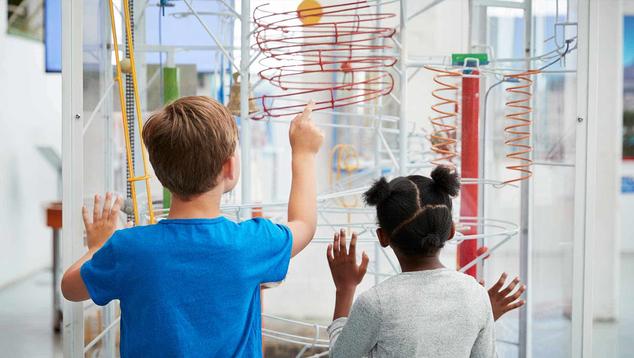WASHINGTON, D.C. -- Slightly more than half of U.S. parents, 55%, report their school-aged children participated in at least one structured program last summer that provided opportunities to learn or refine academic, athletic, creative, social or other skills. Forty-five percent of parents say their children did not participate in any such program. Local day camps and weekly enrichment courses are the most common structured summer programs for U.S. children, followed by summer school and overnight camps. Lower-income children are much less likely than middle- and upper-income children to participate in most types of summer programs.
About half of parents of kindergarten through grade 12 students say there were summer programs they wanted their children to take but couldn’t. The cost of the programs is the main reason they give for not being able to participate. Overall, 32% of U.S. K-12 parents say their child did not participate in desired summer activities specifically because of cost considerations.
These findings are from the National Summer Learning Association-American Camp Association Summer Experiences Survey, conducted by Gallup, which was fielded May 1-15, 2024, with more than 6,800 U.S. parents of children in kindergarten through grade 12. All respondents are members of Gallup’s probability-based panel and completed the survey by web. Parents of multiple children were instructed to answer questions in relation to just one child, who was randomly selected during the interview.
Fifty-Five Percent Participation Rate, Which Varies by Family Income
Slightly more than half of U.S. parents, 55%, say their child participated in at least one structured activity -- specifically, a day camp, an overnight camp, summer school, a weekly enrichment program, a day care program, or a job or internship -- during the 2023 summer months. The gap in participation rates between upper- and lower-income families is nearly 30 percentage points, 67% versus 38%.
The latest American Community Survey estimates that 54 million children in the U.S. are enrolled in grades kindergarten through 12. Assuming each parent provides the same opportunities to all the children in their household, that translates to an estimated 30 million U.S. children participating in a structured summer program last summer, while an estimated 24 million did not.
To estimate how many lower-income children participate in summer programs, the 25 million lower-income children who are eligible for free or reduced lunch programs, according to the National Center for Education Statistics, are considered. These children come primarily from households with annual incomes of $50,000 or less. With 38% of lower-income parents saying their children participated in summer programs, that means an estimated 10 million low-income children had a summer learning opportunity, while roughly 15 million did not.
Day Camps, Enrichment Programs Most Common Summer Activities
Among structured program options, local day camps (22%) and weekly enrichment courses (20%) are the activities parents were most likely to enroll their children in. Thirteen percent of parents say their child attended formal summer school classes, 11% had their child stay at an overnight camp, 9% had a job or internship, and 6% attended day care last summer.
Upper-income parents are more likely than lower-income parents to have a child who participated in all the structured learning programs, except that similar percentages of parents at all income levels report their child attended summer school. The biggest income gap is seen in attendance at day camps, which was an activity for 31% of upper-income parents’ children versus 8% for lower-income parents.
Day camps were the most common activity for elementary (29%) and middle school (24%) children, while summer jobs (32%) were the top activity for high school children.
Activities Typically Happen Outdoors Rather Than in School Buildings
In addition to the type of activity their children were engaged in, the survey asked about the venue at which it took place. Close to half of K-12 parents say their child’s activities took place in an outdoor setting, such as a park or sports field. The next-most-common venues were museums, theaters, science centers or zoos; private buildings; community or recreation centers; or someone else’s house. Fifteen percent of parents had their children involved in summer activities in a K-12 school building, and the same percentage did so at a religious institution’s building.
K-12 school buildings and private properties are more frequently visited by children in structured summer programs than among all school-aged children, generally.
Locations of summer programs are important because federal funds available to support summer programs for children typically go to school districts holding events at school buildings. However, roughly three-quarters of children attended summer activities at venues other than K-12 school buildings.
When parents were asked about their initial plans for the summer of 2024 and where those might take place, the choices of venues were largely similar to what parents reported for 2023.
Half of Parents Wanted More Summer Activities; Cost Is Primary Barrier
About half of K-12 parents, 48%, wished their children could have participated in summer programs, or participated more than they did, last year. This includes 53% of parents who did not place their children in any structured summer programs, and 43% who placed their children in such programs but wanted them to do more. More than six in 10 lower-income parents whose children did not participate in any summer activities wanted their children to.
Parents who wanted their children to participate in more summer activities cite the cost of programs as a major reason for their lack of participation. Forty-two percent of these parents rank cost as the single most important barrier to their child’s participation, and a total of 66% rank it as one of the top three barriers for their family. Seven in 10 lower- and middle-income parents say cost is one of the three most important reasons their child was unable to participate in summer programs.
With 48% of U.S. parents saying they had to forgo or limit their children’s participation in summer learning programs, and 66% of this group citing cost as a barrier, that means 32% of all U.S. K-12 parents could not have their child participate in a summer program specifically because of cost considerations.
Beyond cost, parents mention work conflicts, lack of child interest, lack of awareness of available programs, scheduling conflicts with other child activities, and lack of transportation as other top barriers to child participation in structured summer activities.
Bottom Line
Summers can be challenging for parents, as they try to find ways to make sure their children are properly cared for and involved in engaging activities that allow parents to work or manage other responsibilities. Gallup estimates that slightly more than half of parents have their child enrolled in a structured summer program that allows the child to learn or develop some skill -- be it academic, artistic, athletic or social. But these programs require money to run, and many parents have to limit or forgo structured summer activities for their child because of the costs. That barrier is even harder to overcome for low-income families. Institutions like federal, state and local governments and charitable organizations can help address the financial hurdles, helping to boost child participation in summer programs.
To stay up to date with the latest Gallup News insights and updates, follow us on X @Gallup.
Learn more about how the Gallup Panel works.




